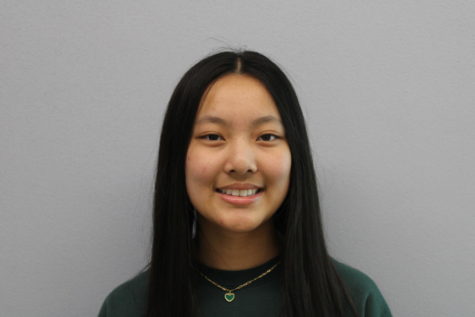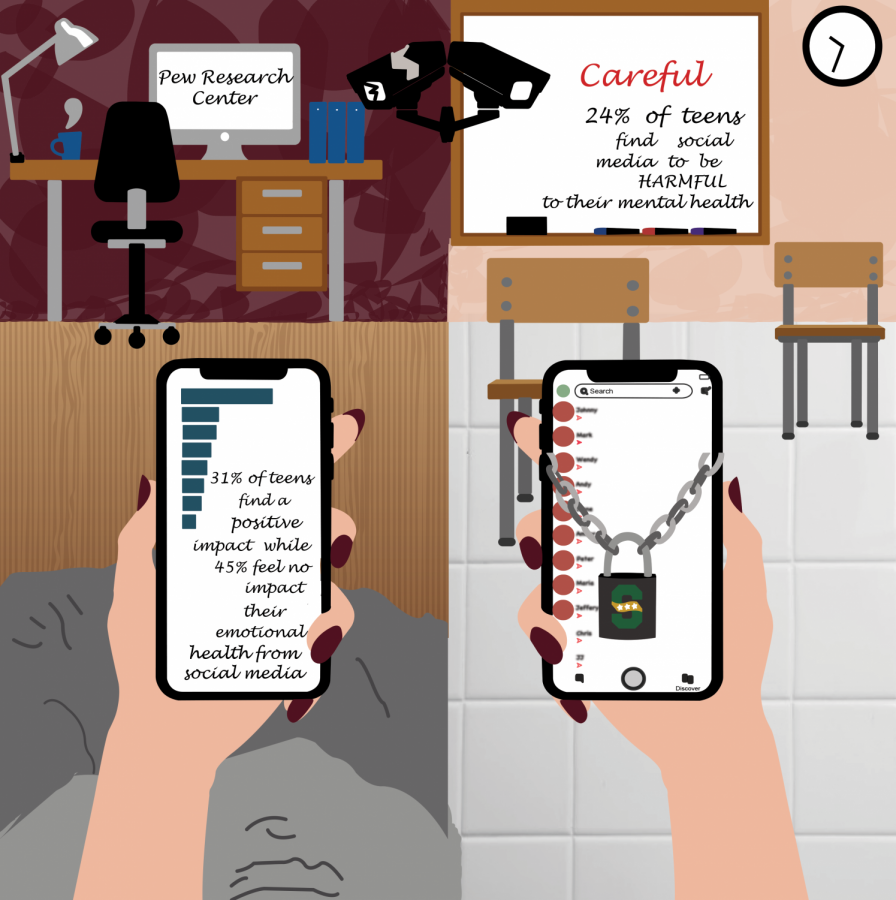Off-Campus, On-Screen
Statesman explores ambiguity of free speech for students on social media
“F*** school, F*** softball, F*** cheer, F*** everything,” 14-year-old high school cheerleader Brandi Levy posted to her Snapchat story. With the mounting pressure of upcoming exams, club softball and a rejection from varsity cheer, Levy decided to relieve some stress by posting a photo of her and a friend sticking up their middle fingers with the above caption. Consequently, Levy was suspended from the cheer team for a year.
Not expecting the suspension, Levy challenged the school’s decision in a case that is now being heard by the Supreme Court in Mahanoy Area School District v. B.L. (Brandi Levy), claiming that her right to free speech had been violated. Although there have been several cases addressing student free speech, none have directly handled how they can be punished for online activity. As a result, the Supreme Court’s decision, which is currently unclear, will ultimately set a precedent for student accountability in regards to social media.
Although free speech itself is not black and white, Statesman believes that students should be allowed to express their freedom of speech in ways that do not disturb the educational process, including in online but off-campus settings.
Students on social media are usually off-campus, making it increasingly difficult to determine whether or not students can be punished by a school for social media activity. However, social media is relatively new, so previous Supreme Court rulings should be applied to guide modern day decisions in the schoolhouse.
In 1969, the Supreme Court heard Tinker v. Des Moines, another case regarding students’ rights to free speech, when a school in Des Moines, Iowa suspended a group of students for wearing black armbands to campus in protest of the Vietnam War. In a 7-2 decision, the Justices ruled in favor of the students, stating that the armbands were not disrupting the educational process.
When discussing student accountability for social media, Statesman encourages school administrators and fellow students to consider this justification. In Levy’s case, for example, she had posted the Snapchat story on a Saturday from a convenience store. Because she was not at school while making the post or targeting any specific person or group, Statesman feels that Levy was not violating the precedent set by Tinker vs. Des Moines, meaning the school was not in a position to determine a punishment.
Rather, those in charge of extracurriculars and athletics at the school had authority over the situation because Levy was a cheerleader. Certain extracurriculars, such as athletic teams or the Freshman Mentor Program, expect members to represent themselves, the program and the school in a more responsible manner than nonmember students. Such additional responsibility means they should be held to a higher standard.
To accommodate the different expectations of extracurriculars, Stevenson created five tiers in its Extracurricular/Co-curricular Code of Conduct that categorize each activity by its specific responsibilities and base punishments on those tiers. In this system, Tier A has the lowest tolerance for Code violations while Tier E has the highest. Stevenson also considers online content of students overstepping the Code as possible violations.
Statesman commends the administration for developing a generally effective tier system to categorize the various activities. Students who partake in Tier A activities, such as Operation Snowball or Tri-M, join with full knowledge of the expectations and responsibilities accompanied with participation. Since students sign up for these activities, they should be held to the expectations of their respective extracurriculars, which makes the tier system both fair and generally effective.
However, the Code was tested last summer at the height of the Black Lives Matter movement and other controversies surrounding Stevenson. When photos resurfaced on Instagram of a student in a Ku Klux Klan (KKK) costume at a local middle school Halloween party from a few years ago, those involved in the pictures went private on social media and issued apologies for the images. Ultimately, none of the students involved were punished by Stevenson and the issue as a whole was ignored by the administration.
While Statesman understands that Stevenson does not necessarily have authority to penalize students for incidents that occured before high school, Statesman feels that the administration should have at least addressed the situation by publicly denouncing the behavior.
Unlike Levy’s Snapchat story, the Instagram photos contained blatant racist content that, intentionally or not, targeted Black students and disrupted the educational process. Although there is often a blur between the intention and impact of an action, especially on social media, when it comes to offensive content, Statesman contends that intention does not excuse students from the guilt or the outcome of their posts.
Holding students accountable for online actions is especially imperative in our digitizing world where people can hide behind screen names and dark humor often goes too far. In 2018, the Pew Research Center reported that 24% of teens surveyed thought that social media had a “mostly negative effect” on our generation with 27% of those students naming “bullying/rumor spreading” as the main reason for their choice.
Although students should not always be actively monitoring their peers’ social media, Statesman feels they have the responsibility to hold themselves and others accountable for what they say online. When encountering inappropriate posts, students should discuss the situation with the peer who made the post, a parent or the administration.
Schools should take a similar approach and be vigilant about what inappropriate content their students are posting. However, routinely monitoring students’ social media is unrealistic and infringes on privacy, so schools should instead educate students on what is appropriate and encourage them to be proactive and report inappropriate posts. Above all, schools must carefully evaluate each reported incident through a discussion between administrators, deans and the students involved.
From Levy to the Stevenson students in KKK costumes, there are clearly various ways that students are using their social media. Tackling online free speech can seem overwhelming, but it is vital to have discussions about it. Just by talking about one case, we can have a better understanding of how students fit into the intersected world of school, free speech and social media.



